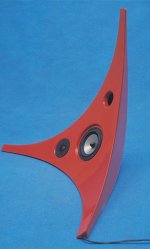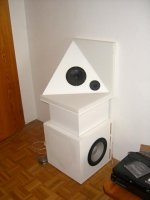There is just one really common way of doing stereo recordings: two cardioid microphones in ~ 30 cm distance, I forgot the angle. Far less common: Two omnidirectional microphones in ~ 20 cm distance with a ~ 20 cm diameter disc or sphere between them. I don´t what role the Blumlein pair (two dipole microphones in a 90°-angle) plays. Probably a rarity. If someone knows a recording, please let me know.
BTW: The only multi-channel-hybrid-SACD I have is from a label that does a lot of electronic ********, maybe nobody even tries to set a standard for "real" multichannel recordings.
BTW: The only multi-channel-hybrid-SACD I have is from a label that does a lot of electronic ********, maybe nobody even tries to set a standard for "real" multichannel recordings.
markus76 said:Welcome to the real world: Multi-miked recordings are standard. Postprocessing in control rooms is standard. How this is done is NOT standardized.
well, by "panpotted" I meant (after quoted DW "Infotheque") of course "multi-miked"
how postprocessing affects intensity (interaural level difference) spatial cues?
best!
graaf
el`Ol said:There is just one really common way of doing stereo recordings: two cardioid microphones in ~ 30 cm distance, I forgot the angle. Far less common: Two omnidirectional microphones in ~ 20 cm distance with a ~ 20 cm diameter disc or sphere between them. I don´t what role the Blumlein pair (two dipole microphones in a 90°-angle) plays. Probably a rarity. If someone knows a recording, please let me know.
I don't know but according to Deutsche Welle "Infotheque" what You describe ("two cardioid microphones in ~ 30 cm distance" or "Two omnidirectional microphones in ~ 20 cm distance with a ~ 20 cm diameter disc or sphere between them") that is various kinds of "delay stereo" is not something common at all, rather on the contrary:
Due to compatibility problems, delay time stereophony is rarely used.
see: http://www9.dw-world.de/rtc/infotheque/stereo/stereo_recording.pdf
Do they misinform interested people?
Perhaps they do but why?
I don't know
best regards!
graaf
markus76 said:? Depends on what kind of postprocessing is performed.
what kind of postprocessing affects intensity (interaural level difference) spatial cues?
graaf said:
I don't know but according to Deutsche Welle "Infotheque" what You describe ("two cardioid microphones in ~ 30 cm distance" or "Two omnidirectional microphones in ~ 20 cm distance with a ~ 20 cm diameter disc or sphere between them") that is various kinds of "delay stereo" is not something common at all, rather on the contrary:
see: http://www9.dw-world.de/rtc/infotheque/stereo/stereo_recording.pdf
Do they misinform interested people?
Perhaps they do but why?
I don't know
best regards!
graaf
I don´t know the percentages, but I always thougth the 30cm setup is the most common for cardioid microphones. Maybe I am wrong.
graaf said:what kind of postprocessing affects intensity (interaural level difference) spatial cues?
I still don't understand the question. Any additional signal can affect everything. Depends on the signal (artificial reverberation, signal from a second mic, etc.).
This is more like how the last topics are discussed in the pro world: http://www.hauptmikrofon.de/theile/Multich_Recording_30.Oct.2001_.PDF
markus76 said:As "classic" stereo recording techniques are discussed in that paper I assume they speak of mono/stereo compatibility.
Mono-compatible recordings were often done with the Decca tree.
el`Ol said:
I don´t know the percentages, but I always thougth the 30cm setup is the most common for cardioid microphones. Maybe I am wrong.
I cleared it that way: looked at thomann.de and saw that virtually all expensive stereo microphones are dipole microphones (Blumlein pair, the most expensive are ribbons). So probably I was wrong that the BP is a rarity, but I think I was right about the common use of the cardioids.
el`Ol said:Anyone who can tell us the percentages (XY, MS, Blumlein pair, 30 cm distance cardioid)?
yeah it will be useful to know
perhaps 90% or even more is multi-miked panpotted stereo?
which is not necessarily something wrong per se as stereo principle stays the same as in case of correct Blumlein stereo
we should also take into account that audiophile market can differ significantly in that respect
it is interesting to know how "true stereo" is understood for instance at Naim, a renowned audiophile gear and record company:
http://www.thenaimlabel.co.uk/true_stereo.htm
actually their "true stereo" microphone setup looks like so called ORTF and is not "true stereo" as understood by Blumlein
and it is simply incorrect from the perspective of theory behind the stereo patent but not as badly as AB-stereo (where no literally no theory explains what is going on)
why spaced microphone arrays cannot work properly is explained i.a. in this interesting essay by Robert E. Green: http://www.regonaudio.com/What Can and Cannot be Expected from Stereo.html
also DW "Infotheque" leaves no space for doubt:
poor directional resolution, the displacement of remote lateral sound sources toward the middle and the risk of a so-called "hole" in the middle
here: http://old.hfm-detmold.de/eti/projekte/semesterarbeiten/hauptmikro/hauptmikro_en.html
we can read that:
The coincident pair (also named XY) is best chosen for optimal sound localization in the room
(...)
AB stereophony (...) is best chosen for a most natural image of the real spatiality.
but why?
ORTF is a kind of compromise:
near-coincident pair (equivalence stereophony) is a combination of both level and runtime differences to create a pleasing room image in addition to good localization of sources.
not "optimal", not "most natural" - just "good", "pleasing"
best regards!
graaf
Will have to get this and do my own recordings:
http://www.thomann.de/de/haun_mbnm622_stejecklin_grenzflaeche.htm
http://www.thomann.de/de/haun_mbnm622_stejecklin_grenzflaeche.htm
hi again!
take a look at those pictures:
http://www.diyaudio.com/forums/showthread.php?postid=1634295#post1634295
http://www.diyaudio.com/forums/showthread.php?postid=1634297#post1634297
and then at the image I attached to the post No 1 in this thread
how about that!
it is nice to see that Mr Linkwitz came to the same conclusion about omnidirectional speaker's placement in small rooms
best regards!
graaf
take a look at those pictures:
http://www.diyaudio.com/forums/showthread.php?postid=1634295#post1634295
http://www.diyaudio.com/forums/showthread.php?postid=1634297#post1634297
and then at the image I attached to the post No 1 in this thread
how about that!
it is nice to see that Mr Linkwitz came to the same conclusion about omnidirectional speaker's placement in small rooms
best regards!
graaf
another one interesting "corner" speaker (representing an approach a bit similar to short Carlsson speakers):
http://www.gampermartino.com/projects/corners/corner-sounds/
best!
graaf
http://www.gampermartino.com/projects/corners/corner-sounds/
best!
graaf
Attachments
Update to the Carlsson project:
After listening to the prototypes for many months I now have the final version running with much better damping inside (rock wool instead of polyester fleece) and outside (Basotect instead of polyester felt). While I am very happy with the tonal improvement I dislike what happened to the imaging. The prototypes had an excellent imaging when fed with real-acoustic recordings and some problems with synthetic acoustic: The instruments were either fixed to the speakers or formed a clump of mud between them. Now the real acoustic recordings are diffuse and without depth, whereas the synth acoustic recordings are much better now and in fact the field where the speakers perform best.
I suspect that the basotect is to blame. I held the polyester felt to my ears and found that they have almost complete transmission, so the triangles probably formed reflectors rather than absorbers before.
Now I am trying to find a compromise. Thinner Basotect may be a solution, but I would be happy to get rid of it completely because it is very fragile. What about real wool felt?
After listening to the prototypes for many months I now have the final version running with much better damping inside (rock wool instead of polyester fleece) and outside (Basotect instead of polyester felt). While I am very happy with the tonal improvement I dislike what happened to the imaging. The prototypes had an excellent imaging when fed with real-acoustic recordings and some problems with synthetic acoustic: The instruments were either fixed to the speakers or formed a clump of mud between them. Now the real acoustic recordings are diffuse and without depth, whereas the synth acoustic recordings are much better now and in fact the field where the speakers perform best.
I suspect that the basotect is to blame. I held the polyester felt to my ears and found that they have almost complete transmission, so the triangles probably formed reflectors rather than absorbers before.
Now I am trying to find a compromise. Thinner Basotect may be a solution, but I would be happy to get rid of it completely because it is very fragile. What about real wool felt?
Attachments
Last edited:
- Home
- Loudspeakers
- Multi-Way
- The Advantages of Floor Coupled Up-Firing Speakers

